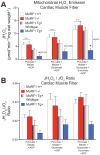MuRF1 activity is present in cardiac mitochondria and regulates reactive oxygen species production in vivo
- PMID: 24733503
- PMCID: PMC4047114
- DOI: 10.1007/s10863-014-9549-9
MuRF1 activity is present in cardiac mitochondria and regulates reactive oxygen species production in vivo
Erratum in
-
Erratum to: MuRF1 activity is present in cardiac mitochondria and regulates reactive oxygen species production in vivo.J Bioenerg Biomembr. 2015 Jun;47(3):281. doi: 10.1007/s10863-014-9597-1. J Bioenerg Biomembr. 2015. PMID: 25515723 No abstract available.
Abstract
MuRF1 is a previously reported ubiquitin-ligase found in striated muscle that targets troponin I and myosin heavy chain for degradation. While MuRF1 has been reported to interact with mitochondrial substrates in yeast two-hybrid studies, no studies have identified MuRF1's role in regulating mitochondrial function to date. In the present study, we measured cardiac mitochondrial function from isolated permeabilized muscle fibers in previously phenotyped MuRF1 transgenic and MuRF1-/- mouse models to determine the role of MuRF1 in intermediate energy metabolism and ROS production. We identified a significant decrease in reactive oxygen species production in cardiac muscle fibers from MuRF1 transgenic mice with increased α-MHC driven MuRF1 expression. Increased MuRF1 expression in ex vivo and in vitro experiments revealed no alterations in the respiratory chain complex I and II function. Working perfusion experiments on MuRF1 transgenic hearts demonstrated significant changes in glucose oxidation. However, total oxygen consumption was decreased [corrected]. This data provides evidence for MuRF1 as a novel regulator of cardiac ROS, offering another mechanism by which increased MuRF1 expression may be cardioprotective in ischemia reperfusion injury, in addition to its inhibition of apoptosis via proteasome-mediate degradation of c-Jun. The lack of mitochondrial function phenotype identified in MuRF1-/- hearts may be due to the overlapping interactions of MuRF1 and MuRF2 with energy regulating proteins found by yeast two-hybrid studies reported here, implying a duplicity in MuRF1 and MuRF2's regulation of mitochondrial function.
Conflict of interest statement
There are no conflicts of interest to disclose.
Figures






Similar articles
-
The ubiquitin ligase MuRF1 protects against cardiac ischemia/reperfusion injury by its proteasome-dependent degradation of phospho-c-Jun.Am J Pathol. 2011 Mar;178(3):1043-58. doi: 10.1016/j.ajpath.2010.11.049. Am J Pathol. 2011. PMID: 21356357 Free PMC article.
-
Fenofibrate unexpectedly induces cardiac hypertrophy in mice lacking MuRF1.Cardiovasc Pathol. 2016 Mar-Apr;25(2):127-140. doi: 10.1016/j.carpath.2015.09.008. Epub 2015 Oct 29. Cardiovasc Pathol. 2016. PMID: 26764147 Free PMC article.
-
MuRF1-dependent regulation of systemic carbohydrate metabolism as revealed from transgenic mouse studies.J Mol Biol. 2008 Jun 13;379(4):666-77. doi: 10.1016/j.jmb.2008.03.049. Epub 2008 Apr 3. J Mol Biol. 2008. PMID: 18468620
-
MuRF1 is a muscle fiber-type II associated factor and together with MuRF2 regulates type-II fiber trophicity and maintenance.J Struct Biol. 2010 May;170(2):344-53. doi: 10.1016/j.jsb.2010.02.001. Epub 2010 Feb 10. J Struct Biol. 2010. PMID: 20149877 Free PMC article.
-
Cardiac muscle ring finger-1--friend or foe?Trends Cardiovasc Med. 2010 Jan;20(1):12-6. doi: 10.1016/j.tcm.2010.03.001. Trends Cardiovasc Med. 2010. PMID: 20685572 Free PMC article. Review.
Cited by
-
Emerging Strategies Targeting Catabolic Muscle Stress Relief.Int J Mol Sci. 2020 Jun 30;21(13):4681. doi: 10.3390/ijms21134681. Int J Mol Sci. 2020. PMID: 32630118 Free PMC article. Review.
-
Post-translationally modified muscle-specific ubiquitin ligases as circulating biomarkers in experimental cancer cachexia.Am J Cancer Res. 2017 Sep 1;7(9):1948-1958. eCollection 2017. Am J Cancer Res. 2017. PMID: 28979816 Free PMC article.
-
Regulation of Mitochondria-Derived Immune Activation by 'Antiviral' TRIM Proteins.Viruses. 2024 Jul 19;16(7):1161. doi: 10.3390/v16071161. Viruses. 2024. PMID: 39066323 Free PMC article. Review.
-
The molecular role of Sigmar1 in regulating mitochondrial function through mitochondrial localization in cardiomyocytes.Mitochondrion. 2022 Jan;62:159-175. doi: 10.1016/j.mito.2021.12.002. Epub 2021 Dec 10. Mitochondrion. 2022. PMID: 34902622 Free PMC article.
-
Increasing Cardiomyocyte Atrogin-1 Reduces Aging-Associated Fibrosis and Regulates Remodeling in Vivo.Am J Pathol. 2018 Jul;188(7):1676-1692. doi: 10.1016/j.ajpath.2018.04.007. Epub 2018 May 23. Am J Pathol. 2018. PMID: 29758183 Free PMC article.
References
-
- Centner T, Yano J, Kimura E, McElhinny AS, Pelin K, Witt CC, et al. Identification of muscle specific ring finger proteins as potential regulators of the titin kinase domain. [Research Support, Non-U.S. Gov’t Research Support, U.S. Gov’t, P.H.S.] J Mol Biol. 2001;306(4):717–726. doi: 10.1006/jmbi.2001.4448. - DOI - PubMed
Publication types
MeSH terms
Substances
Grants and funding
LinkOut - more resources
Full Text Sources
Other Literature Sources
Research Materials
Miscellaneous

